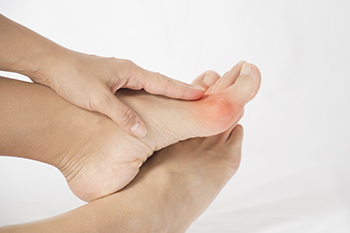A bump, or bunion, on the inside of the big toe is caused by an outward protrusion of the bones at the base of the big toe. When these bones angle outwardly, rather than being in a linear alignment, they force the big toe to lean towards the second toe instead of pointing straight ahead. The severity of the deformity and its symptoms will dictate its treatment method. A podiatrist may try to change the patient’s footwear and use padding or corrective devices inside the shoe to help guide a mild bunion deformity back into normal alignment. Pain may be alleviated with over-the-counter medicine. More severe misalignment and intense pain may require a surgical intervention (bunionectomy). A bunionectomy removes swollen tissue, straightens the big toe, and re-aligns the bones in the big toe joint. If you have a painful and unsightly bunion, contact a podiatrist for an evaluation and consultation regarding your treatment options
If you are suffering from bunions, contact one of our podiatrists of Sutera and Jones Surgical Podiatry. Our doctors can provide the care you need to keep you pain-free and on your feet.
What Is a Bunion?
A bunion is formed of swollen tissue or an enlargement of boney growth, usually located at the base joint of the toe that connects to the foot. The swelling occurs due to the bones in the big toe shifting inward, which impacts the other toes of the foot. This causes the area around the base of the big toe to become inflamed and painful.
Why Do Bunions Form?
Genetics – Susceptibility to bunions are often hereditary
Stress on the feet – Poorly fitted and uncomfortable footwear that places stress on feet, such as heels, can worsen existing bunions
How Are Bunions Diagnosed?
Doctors often perform two tests – blood tests and x-rays – when trying to diagnose bunions, especially in the early stages of development. Blood tests help determine if the foot pain is being caused by something else, such as arthritis, while x-rays provide a clear picture of your bone structure to your doctor.
How Are Bunions Treated?
- Refrain from wearing heels or similar shoes that cause discomfort
- Select wider shoes that can provide more comfort and reduce pain
- Anti-inflammatory and pain management drugs
- Orthotics or foot inserts
- Surgery
If you have any questions, please feel free to contact one of our offices located in Media, Glen Mills, Riddle Memorial Hospital, and Concordville, PA . We offer the newest diagnostic and treatment technologies for all your foot care needs.

